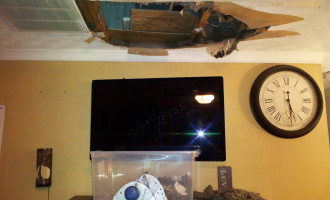The Most Common Reasons Your Roof May Leak

Roof leaks are a frustrating and expensive issue. Because it can be something as small as a single rusted nail, but cause hundreds of dollars in drywall damage, spoil your insulation, and cost you time and money in repainting your ceiling, not to mention rotted plywood, and patching your shingles. In serious cases roof leaks also lead to mold putting both your biggest investment and family at serious risk.
When it comes to leaks our motto is: An ounce of prevention is worth a pound of cure!
New Article: Do Gutter Guards Work?
1. Leaking Pipe Boots and Worn Out Pipe Jacks
Your entire roof is made of fiberglas backed asphalt, tile, or even metal or glass, save a few points. Your pipe boots! They are PVC boots that vent from your bathrooms and are protected by a neoprene rubber collar. They are the single most vulnerable area on your roof. Your dog could chew through the collar in a few hours, weather can wear out the boot collars in a few years.
UV rays will bake the rubber over time and cause it to crack. Woodpeckers or squirrels might also bite or peck at the collar, especially when it comes to lead pipes.
Luckily there’s an extremely easy solution. Get a free roof inspection! If your pipe boots need replacing our professional recommendation is to use a perma boot. It is a lifetime (50 year) warranteed hard plastic boot that covers your pipe jack so you never have to worry about it again!
2. Rusty Nails & Wind Damaged Shingles
It’s extremely common for wind driven rain to get underneath your shingles after they’ve been damaged by the wind. Because the shingle seals at the bottom, once the seal is broken there’s nothing protecting the nails (which essentially create a necessary hole in your roof) underneath and they begin to rust. Atlas Chalet shingles are especially easily damaged by the wind and in the case pictured above just one rusted nail had ruined the insulation and stained the drywall in the upstairs bathroom.
Because roofing nails are made of galvanized steel they will rust once exposed to water. Just 1 rusted nail can let in a GALLON of water during 1 hour of heavy rain.
The fix is very easy; Get a free roof inspection! And have your roofer caulk any rusted nails to seal water out. If you do have sufficient storm damage you may be eligible for insurance to pay for a new roof as well. Ask your roofer. We also recommend that you have your attic inspected; after all, half your roof is in your attic.
3. Flashing & Dead Valleys
Brick chimneys and any area where shingles meet a wall require flashing. This is a series of metal pieces that stair step down to prevent water from getting under the wall and creating rot. If the flashing is poorly done or nonexistent leaks will often occur.
The other problem is what’s called a Dead Valley, where the roof angles down into a wall. These areas MUST be flashed properly becauase often leaves & debris will clog the valley creating a small pool of water that’s guaranteed to cause leaks!
Once you have your roof inspected, expect to pay quite a bit more for this kind of repair. Flashing or re-flashing is both labor intensive and quite specialized work. Don’t pinch pennies on this crucial area of your roof.
Resources
1. http://www.permaboot.co/
2. http://www.cdc.gov/niosh/topics/indoorenv/mold.html
3. Robert Kinghorn From Ridge Valley Roofing in Newnan, GA











